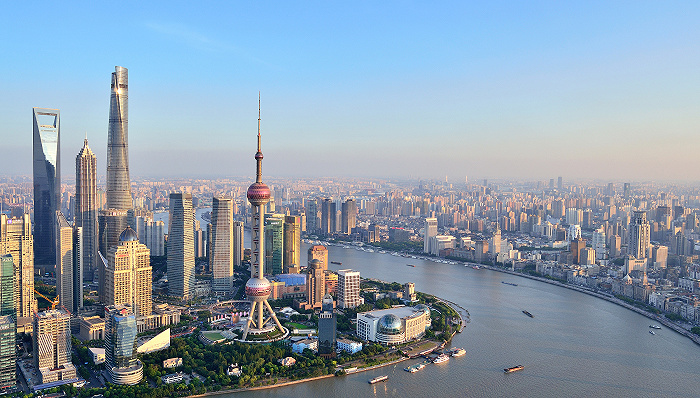
CBNFridaySpecial丨ElNi?oisofficiallyh
时间:2023-07-01 10:01:14 来源:证券之星 阅读量:15456
One consistent theme of the 2023 summer is, almost beyond any doubt, the relentless heat.
Most regions of China are forecast to experience their first heat wave of the year this week, with maximum temperatures soaring to 37 degrees Celsius in some areas, the China Meteorological Administration said on Monday.
Beijing, capital of the country, together with parts of northern China, sizzles under one of the worst heat waves in history.
The observatory in southern Beijing on Saturday for the first time recorded temperatures above 40 C for a third consecutive day, according to the meteorological authorities.
In nearby Hebei province and the port city of Tianjin, temperatures have also soared above 40 C over the past few days, prompting authorities to issue “red” alerts for extreme weather, the highest in China’s four-tier weather alert system.
On Thursday, Beijing experienced its second-hottest day on record – with temperatures soaring to 41.1 C. It was also the highest temperature ever recorded in China’s capital during the month of June.
Chinese meteorologists say the current heat wave has been caused by warm air masses associated with high-pressure ridges in the atmosphere and compounded by thin cloud covers and long daylight hours around the summer solstice.
China issued the first forecast for high temperatures and heat stroke for this year on June 15, 13 days earlier than the average release date of most years.
Entering June, record-breaking readings on the thermometer has made it clear that after months of warning, El Ni?o has officially arrived— and it may be the hottest in human history.
Earlier this month, scientists at the US National Oceanic and Atmospheric Administration confirmedthat the climate event known as El Ni?o has officially emerged for the first time in more than four years, and it’s expected to bestrongthis time around.
An El Nino system is building along the equator in the eastern Pacific Ocean, which could send global average temperatures soaring to a record high this year or in 2024, the China Meteorological Administration said.
Other countries in Asia have experienced deadly heat waves in recent weeks, which scientists say are aggravated by rising global temperatures.
Since the beginning of June, heat waves have resulted in nearly 100 deaths in two of India’s most populous states. In Spain, recent high temperatures are dealing a blow to farmers who have yet to recover from last year’s drought. In the US, Texas power prices surged 80% this week as a heat wave put added strain on the grid.
“Super El Ni?o”
The entire world has been experiencing extreme temperatures. Researchers have indicated that with rising ocean temperatures worldwide and the onset of El Ni?o in the Pacific, 2023 could potentially become the hottest year on record, according to a report from China Science Daily.
Climate scientists have predicted there is a 90 percent chance that the phenomenon will take hold in the latter half of the year. Its impacts are unlikely to be felt until the end of the year, but there is concern it could develop into a quot;super El Ninoquot;.
The World Meteorological Organization released a report on May 17 stating that due to the accumulation of greenhouse gases and the influence of natural El Ni?o events, global temperatures may reach record levels in the next five years. It assigns a 98 percent probability to the average temperature from 2023 to 2027 being hotter than the past five years.
So how does El Ni?o form and what to expect during one?
Occurring every three to seven years, an El Ni?o describes theunusual warming of the eastern Pacific Ocean, just off the coast from Peru. The phenomenon is declared when sea temperatures in the region rise 0.5 °C above the long-term average.
This subsequently drives surface air temperatures and pressure changes throughout the equator, which then go on toaffect seasonal weather over both hemispheres.
The event is driven by slow, natural fluctuations in ocean currents and wind patterns, but the climatic impacts are felt over many months – and even years – across the planet.
The hottest years on recordtend to happen during El Ni?o. The last major El Ni?o from 2014 to 2016 led to each of those years successively breaking the global temperature record and 2016 remains the hottest year ever recorded.
Variations in wind strength and ocean temperatures in the vast Pacific Ocean lead to two distinct climate patterns, El Ni?o and La Ni?a. The switch between them happens irregularly, every three to seven years, usually with neutral years in between. El Ni?os tend to last about a year but the La Ni?a phase can be longer, and 2023 has brought the end of an unusual run of three successive La Ni?a years.
There is a potential swift switch this year from the La Ni?a period, toward the El Ni?o phenomenon, said Ma Jun, director of the Beijing-based Institute of Public and Environmental Affairs.
The fallout of El Ni?o not only includesincreased global temperatures and more frequent and severe wildfires and power outages, but also heightened rainfall, intense flooding and droughts, and mass fish die-offs. The list goes on.
But it’s worth noting that a country’s experience of El Ni?o varies from region to region and season to season, and is dependent on the intensity of the phenomenon when it comes to pass.In parts of the world, like the baked, semi-arid mid-west of the US, an El Ni?o can bring increased rainfall during the summer months. Conversely, it can drive unusually warm temperatures and dry conditions in regions of Africa that are normally very wet.
Costs of extreme weather
The main concern from the changing El Ni?o-Southern Oscillation cycle is that it brings more catastrophic events such as wildfires or floods creating humanitarian crises and major ecological damage, which come with economic costs.
Less immediately visible will be its economic effects: El Ni?o is set to aggravate the failure of the prevailing growth-based economic model, with calamitous results for the world’s poor.
However, scientists do not always see eye to eye when it comes to the damage of El Ni?o on the economy. A recent research by Callahan and Mankin, which has been widely cited in the media, attribute “$4.1 trillion and $5.7 trillion in global income losses to the 1982-83 and 1997-98 El Ni?o events”.
Researchers at Oxford Economics are skeptical of these results. According to Ben May, director of Global Macro Research at Oxford Economics, the damage bill from a natural disaster can be huge for an individual economy. But at the global level, total annual damage costs from natural disasters are typically small, when measured as a share of annual world output.
In 2011, a bad year for natural disaster damage, the estimated cost of global damage was about 0.5 percent of nominal US dollar-weighted global GDP. From 2019 to 2021, the cost has averaged less than 0.2 percent of global GDP.
The impact of El Ni?o on crops and food prices is uncertain as well, as academic studies suggest that the impact of ENSO on the yield of key crops is small at a global level. While the yield from large areas of cultivated land may fall significantly due to El Ni?o or La Ni?a, causing price surges in these regions, other regions may benefit from significantly higher yield. For instance, El Ni?o causes a reduction in mean global rice and wheat yield of about 1.3 percent and the adverse impact on corn is relatively small, whereas soybean yield typically increase.
However, the IMF Working Paper also shows that ENSO can account for almost 20 percent of real commodity price inflation over a multi-year period.
Higher food prices are a common theme across El Ni?o events, according to a recent Deutsche Bank report.
According to Bloomberg Economics modeling, previous El Ni?os resulted in a marked impact on global inflation, adding 3.9 percentage points to non-energy commodity prices and 3.5 points to oil.
今夏以来,我国提早开启了“淄博烧烤”模式:多地气温争先恐后冲上40℃,2023年会成为“史上最热夏天”吗?
先是从5月份开始至6月10日,云南、四川、贵州、广西、广东等地,陆续出现高温天气。
接着,北方也开始了高温。6月11日,新疆包揽了我国高温排行榜前十位。石河子出现6月首个40℃的高温、托克逊连续两天46℃、艾丁湖气象站出现48.5℃的高温,跻身全球高温榜前列。
6月中旬以来,京津冀区域气温迅速攀高。其中,北京、天津、河北中南部和东北部最高气温在38℃~41℃。区域最高气温出现在22日北京怀柔区汤河口站、天津滨海新区大港站,均达到41.8℃。北方多地37℃以上的高温影响面积约45万平方公里,京津冀和山东等地有21个国家气象站日最高气温突破历史极值;南方地区大范围强降雨持续,100毫米以上降雨覆盖面积达20.57万平方公里。
从6月27日开始,新一轮高温又将上线,提升京津冀地区“炎值”,预计北京、天津、河北南部还会出现40℃以上的超高温天气。7月1日高温范围和强度达到最大,并有可能打破历史极值,具有一定极端性。
目前预计,京津冀地区的整个6月高温日数有望突破同期纪录——12.1天。
不仅是中国,“200年一遇”的热浪让东南亚措手不及。
早在今年4月,泰国就刷新了历史上最高温的纪录,气温达45.4摄氏度,而邻国老挝5月份也连续两天达到43.5摄氏度的最高气温。6月1日,越南打破了历史上最热的6月纪录,气温达到43.8摄氏度。再加上高湿度,东南亚的酷热变得更加难以忍受和危险。
罕见的热浪同样袭击了欧美。美国得克萨斯州、新墨西哥州等地气温持续刷新纪录,数千万人处于极端高温预警之下。部分地区气温刷新了有记录以来的最高值。欧洲想方设法应对高温,德国地方设立抗旱专员职位,荷兰将启动国家高温计划,西班牙缩短学校上课时间。
今夏以来,北半球多地遭遇极端高温,伴随着这些高温天气,有一个词会被经常提及:厄尔尼诺。
厄尔尼诺,真的来了
6月以来,赤道中东太平洋海表温度明显上升,目前已进入厄尔尼诺状态。据国家气候中心预测,未来三个月赤道中东太平洋将维持厄尔尼诺状态,海温指数持续上升,将在今年秋季形成一次中等以上强度的东部型厄尔尼诺事件。
美国海洋和大气管理局近日发布的厄尔尼诺现象观察报告预计,在今年5月至7月期间,“厄尔尼诺”出现的几率为62%。根据NOAA气象学家休瑞的说法,今年之内全球出现“厄尔尼诺”现象的概率超过85%。休瑞表示,“我们目前看到热带太平洋有大量的次表层海洋热量在积累,这些热量最终会涌向海面。”她认为,“厄尔尼诺”现象正在持续酝酿中,“证据已经非常清晰”。
今年5月17日,世界气象组织发布的报告显示,全球气温在未来五年可能会达到创纪录的水平,这主要受到温室气体的积聚和自然发生的厄尔尼诺现象的影响。
报告指出,有98%的可能性,在未来五年中至少有一年,以及整个五年,将是有记录以来最热的年份。
此次厄尔尼诺出现时间比预想提前一到两个月,且发展较快,到冬季发展为强厄尔尼诺的概率为56%。
如果出现强厄尔尼诺,2024年将很有可能成为有记录以来最热的一年。但明年是否会受厄尔尼诺影响成为有气象记录以来最热的一年,仍有不确定因素。
简单而言,厄尔尼诺是指赤道中东太平洋海表温度持续、显著偏暖的气候现象。正常情况下在信风带影响下,大量温暖的海水自东向西流动,形成了稳定的洋流。这种洋流造成太平洋西侧海水温度偏高。而东侧海水温度则较低,空气相对干燥,气候也就相对干旱。
但是在有些年份或一年中的某些月份,信风强度异常减弱,造成赤道地区自东向西流动的洋流减弱,西太平洋的海水温度异常降低,本来比较湿润的气候趋于干旱,原本干旱的气候趋于湿润。
简单的说,就是应该多雨的地方降水减少了,应该干旱的地方降水却在增加,这便是厄尔尼诺现象。
专家表示,在全球变暖背景下,叠加中等以上强度厄尔尼诺事件,可能导致极端天气频次更多、范围更广、强度更强。
1951年以来,赤道中东太平洋共发生了21次厄尔尼诺事件,曾给我国带来高温热浪、洪涝和干旱等影响。
国家气候中心分析历史数据发现,厄尔尼诺发展年夏季,华北南部、华中北部、华东中部、西北地区东部等地气温易偏高,部分地区高温日数可达30天以上。
“厄尔尼诺发展年夏季,西太平洋副热带高压往往偏南偏强,造成我国南方地区降水偏多。近期江南、华南等地强降水频发就是受到厄尔尼诺状态影响的体现之一。”中国气象局气候服务首席专家周兵说。
而厄尔尼诺通常伴随着拉尼娜的到来,这是两种对立的反常自然现象,原因在于信风和洋流的异常。据国家气候中心预测,在厄尔尼诺发展加强背景下,预计今年夏季我国华东南部、华中南部、西南地区南部降水易偏多,发生洪涝的风险大;西北地区东部降水易偏少,发生气象干旱的可能性大。而拉尼娜现象则会造成长江流域出现干旱,北方降水异常偏多,在拉尼娜现象出现的冬季极易形成雪灾。
不过,专家表示,影响我国气候异常尤其是高温、干旱、洪涝等极端事件的因子复杂,厄尔尼诺只是其中一个重要因子。
中国科学院大气物理研究所季风系统研究中心副主任魏科认为,高温天气不可避免,因为目前除东太平洋外,已逐渐出现偏暖迹象,但是今年的厄尔尼诺现象没有2016年的超级厄尔尼诺现象那么强,未必能达到“史上最热夏天”。
厄尔尼诺“定损”不易
通常来讲,“厄尔尼诺”现象会使全球气候模式趋于不稳定,灾害天气频发。在厄尔尼诺年,东南亚、澳大利亚、南亚次大陆等区域可能出现干旱天气,而从太平洋中部赤道地区到南美大陆西岸可能降雨增多,意味着拉丁美洲可能出现洪灾。
恶劣的气候也会给全球粮食供应带来压力。干旱和洪灾等天气会直接扰乱粮食生产秩序,而且气温持续升高带来的热力效应也会降低土壤肥力和粮食产量。受气温升高的影响,粮食作物的品质会下降,从而增加了粮食浪费的可能性,进一步增加饥饿人口的数量。
世界气象组织近日发文称,年内出现厄尔尼诺气候现象的可能性越来越大,预计将带来高温和极端天气,进一步影响粮食安全问题,多个主要谷物生产国和出口国将面临风险。进入6月,受关键产区恶劣天气导致作物减产的担忧升温,国际小麦、玉米、大豆期货开启了新一轮涨价行情。
按照国际货币基金组织发布的报告,厄尔尼诺事件不仅对当年全球经济造成冲击,也会导致随后多年经济体增长乏力。IMF预计,新一轮强劲的厄尔尼诺影响将更为严重,可能在长达十年的时间里抑制热带国家的经济活动。
报告称,厄尔尼诺现象对不同地区的经济影响存在较大差异。主要经济体中澳大利亚、智利、印度、印尼、日本、新西兰和南非的经济活动都会因为气候冲击而短暂下降,而美国、加拿大、墨西哥、泰国等经济体和欧元区可能从中受益。
厄尔尼诺会为全球经济带来不确定性,而具体对经济产生多大的影响,科学界却未有定论。
近日,美国科学家在《科学》发布报告称,厄尔尼诺现象预计在今年再次出现,并将在全球范围内造成数万亿美元的经济损失。这项研究是第一批评估厄尔尼诺现象长期损失的研究之一,其预测的损失远远超过之前的研究。
该报告的研究人员分析1982年至1983年和1997年至1998年厄尔尼诺事件后几十年的全球经济,发现了经济增长放缓的“持久特征”,即在每一次事件发生后的5年里,全球经济分别损失了4.1万亿美元和5.7万亿美元,其中大部分由贫穷的热带国家承担。
研究人员预测,鉴于气候变化可能会加剧厄尔尼诺现象的出现频率和强度,即使世界各国减少碳排放的承诺成为现实,21世纪全球经济损失也将达到84万亿美元。他们估计,到2029年,仅2023年的厄尔尼诺现象就可能给全球经济造成3万亿美元的损失。到本世纪末,厄尔尼诺现象将影响约84万亿美元的GDP增长。其中,热带和南半球地区的风险最为严重。
然而,有经济学家对此结论表示质疑。牛津经济研究院全球宏观研究主任Ben May认为,厄尔尼诺现象对全球经济的影响是复杂和不均衡的。一方面,有些国家和地区可能因为厄尔尼诺现象而受益,例如北美、欧洲、澳大利亚等温带地区,可能会有更温暖和湿润的气候,有利于农业生产和能源消费。比如厄尔尼诺现象发生时,美国的西部地区一般是偏暖干,美国的东南部分,一般会偏暖湿一些,南美洲降水偏多,会影响到这一地区农产品的产量,尤其像玉米、大豆、小麦等作物。当这一地区降水偏多时,有助于农作物产量的增加,其价格也会有所降低。
另一方面,有些国家和地区可能因为厄尔尼诺现象而受损,例如南美、非洲、亚洲等热带和亚热带地区,可能会遭受更严重的干旱或洪水,影响农业和渔业产量和质量。
May强调,厄尔尼诺现象不会改变全球经济的基本趋势和结构,而是暂时性的冲击。他预计,厄尔尼诺现象对全球经济增长率的影响不会超过0.1个百分点。
Executive Editor: Sonia YU
Editor: LI Yanxia
Host: Stephanie LI
Writer: Stephanie LI
Sound Editor: Stephanie LI
Graphic Designer: ZHENG Wenjing, LIAO Yuanni
Produced by 21st Century Business Herald Dept. of Overseas News.
Presented by SFC
编委: 于晓娜
策划、编辑:李艳霞
播音:李莹亮
撰稿:李莹亮
音频制作:李莹亮
设计:郑文静、廖苑妮
21世纪经济报道海外部 制作
南方财经全媒体集团 出品
声明:本网转发此文章,旨在为读者提供更多信息资讯,所涉内容不构成投资、消费建议。文章事实如有疑问,请与有关方核实,文章观点非本网观点,仅供读者参考。
 韩国多家晶圆代工商产能利用率急剧下滑三星电子除外
韩国多家晶圆代工商产能利用率急剧下滑三星电子除外 飞猪联合新东方在线、启航教育、研途推出考研酒店活动,覆盖220余
飞猪联合新东方在线、启航教育、研途推出考研酒店活动,覆盖220余 山灵M0Pro便携式无损音乐播放器发布:超小体积支持双DAC,售
山灵M0Pro便携式无损音乐播放器发布:超小体积支持双DAC,售 2023年春运是哪40天
2023年春运是哪40天 好赛道配好赛手,生科自动化领域迎来新势力?!
好赛道配好赛手,生科自动化领域迎来新势力?!
- 1耐克NKE.US财报未达预期,华尔街
- 2金融界周婷:上海ESG披露水平全国领
- 3奥雅股份6月30日收盘数据:较昨日下
- 4飞沃科技6月30日收盘数据:较昨日下
- 5宏创控股6月30日收盘报4.23元,
- 6恒润股份6月30日全天上涨2.64%
- 7远方信息6月30日收盘小幅上涨0.9
- 8佛塑科技6月30日收盘小幅上涨0.9
- 9铁建重工6月30日收盘报4.81元,
- 10英可瑞6月30日收盘小幅上涨0.27
















